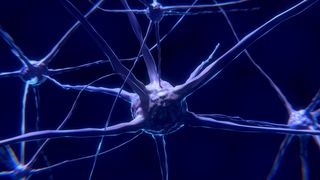Neuroscience
Evolution of the Primate Brain: Size Is Just a Start
From prefrontal white matter to squiggly surface grooves, our brain stands out.
Posted September 21, 2018

In the last post, we left off with the knowledge that human brains grow for longer into adulthood compared to chimp brains. But why would that matter? Turns out, that time allows for increased development of structures and tissues that may underlie our uniquely-human traits.
Let's start with the prefrontal cortex.
Our prefrontal cortex is the region of our brain located just behind our forehead, involved in higher order cognitive functions, including but not limited to decision making, planning, fine motor skills, and abstract thinking.
Phineas Gage: A brain trauma case study
Maybe you first learned about the prefrontal cortex through the story of Phineas Gage, a railroad foreman who, in 1848, had a tamping iron—a long rod he was using to pack explosive powder into a hole, a few feet long and about an inch in diameter—penetrate through his left cheek and out through his skull, tearing through his prefrontal cortex.
Gage was blinded in his left eye, but survived. His personality, however, changed dramatically. Those who knew him reported an almost immediate shift in his emotional stability. He began showing a lack of self-awareness, yelling profanities and driving those who knew him away. He was no longer dependable at work and could no longer hold a job. He died of an epileptic seizure 11 years after the accident, at age 36, after taking on a series of odd jobs both within and outside the United States.
This event, although unfortunate, gave a peek into the importance of different brain regions, and provided support for the theory (at the time, a disputed one) that different regions of the brain served different functions.
The ever-intriguing prefrontal cortex
For years, the underlying importance of the prefrontal cortex in human versus non-human primate behavior has been an issue for debate. In 2002, researchers at the University of California San Diego used magnetic resonance (MRI) scans of humans, apes, and monkeys to look at differences in frontal cortex volume as well as gross anatomical differences. They found that lesser apes, like gibbons, and monkeys had a smaller frontal cortex than humans, but that, like humans, great apes showed frontal cortex enlargement.
Fifteen years later, a separate group of researchers looked at prefrontal cortex growth across different primate species and found that the prefrontal cortices of great apes and humans did not follow a standard allometric growth pattern—there was a shift in the timing and degree of prefrontal cortex growth that didn’t line up with what had been seen in other primates. When an organism moves away from a common allometric growth pattern it can be an indicator of evolutionary genetic shift. In this case, it suggested that genetic changes resulting in higher order cognitive function surfaced somewhere around 15 million years ago, at the start of the great ape lineage.
So, if the degree of prefrontal cortex expansion isn’t strikingly different, what could be underlying the cognitive variability between humans and apes? The answer may (partly) lie in gray and white matter volumes.
Vertebrate brains contain both gray and white matter. Recently, a group of researchers reported that the total amount of both gray and white matter was disproportionately larger in the prefrontal cortex of humans compared to non-human primates. But what could this mean for human cognition? Social skills?

Gray matter is comprised of local neuron networks that include dendrites (nerve cell branches that transmit signals to the cell body) and non-myelinated axons. Increased gray matter in regions of the prefrontal cortex has been shown to positively correlate with self-control, a trait somewhat specific to humans.
White matter is made up mainly of long-range myelinated axons (axons covered with a protective myelin sheath) and has a whitish appearance because of the high lipid content of myelin. White matter was first considered a tissue of little importance, but has since been shown to be essential for cognitive function, directing communication between brain regions.
In 2011, a group of researchers investigated the volume of white matter in chimpanzees and humans. White matter development in Rhesus macaques, a well known species of Old World monkey, had already been shown to differ from that in humans-- white matter reaches adult volumes in macaques at a much earlier age than in humans. To investigate prefrontal cortex white matter growth over years of development in chimpanzees, the research team collected MRI scans. They found that, in chimpanzees, the volume of prefrontal white matter stayed immature until adulthood, a developmental trait also seen in humans.
When they compared chimpanzee white matter to human white matter, however, chimpanzee white matter volume increased at a slower rate during infancy. Although not incredibly well understood, this rapid increase is hypothesized to underlie increased neural connectivity, and therefore the development of more complex social interactions and skills, in humans.
Humans show increased flexibility in brain development
Much brain research comparing humans to their primate relatives has been focused on cortex expansion and relative increase in brain size, but flexibility in brain development has been far less studied. In 2015, researchers developed a system for estimating the genetic basis of brain size as well as cortex organization in humans and chimpanzees. To do this, they used MRI scans to examine the brains of 218 humans and 206 chimpanzees, comparing phenotypic similarities between related individuals. They not only measured differences in brain size but also in sulci (grooves often described as “squiggles” on the surface of the brain) shape and location. Sulci increase the surface area of the brain, allowing for continued growth, a mark of increased plasticity. Brain plasticity, or the ability of the brain to reorganize its circuitry in response to environmental stimuli, has been shown to underlie changes in memory and behavior.
Although brain size between related individuals did not significantly vary, closely related humans, for example brothers, showed considerably more variation in shape and placement of their sulci than did closely related chimpanzees. They found that cortex organization and brain size is highly heritable in chimpanzees, however, in humans these traits were less heritable. This indicated increased plasticity in human brain development.
In other words, humans would be more able to adapt to their environment, an important trait that may in part underlie how humans have been able to thrive under such varied circumstances over time.




